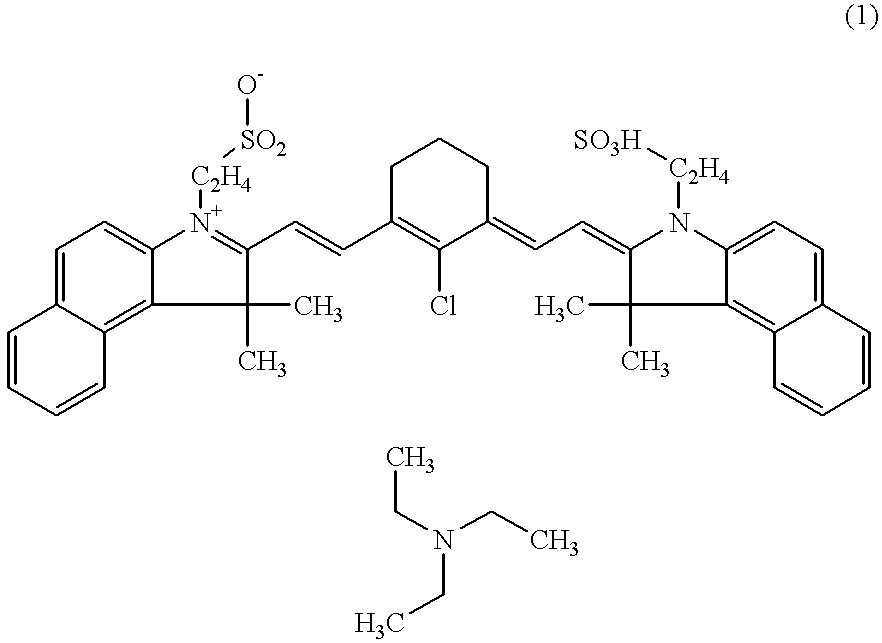Heat mode sensitive imaging element for making positive working printing plates
a printing plate and heat-mode-sensitive technology, applied in thermography, photosensitive materials, instruments, etc., can solve the problems of complex development and associated developing liquids, cumbersome and laborious methods of working, and insufficient photosensitive coating to be directly exposed with a laser, so as to increase the run length of printing plates and improve durability.
- Summary
- Abstract
- Description
- Claims
- Application Information
AI Technical Summary
Benefits of technology
Problems solved by technology
Method used
Image
Examples
example 2
On the lithographic base described in example 1, was first coated a layer from an 8.6%wt solution in tetrahydrofuran / methoxypropanol 55 / 45 ratio, with a wet coating thickness of 14 .mu.m. The resulting layer contained 88% of Alnovol SPN452 and 12% of 3,4,5-trimethoxybenzoic acid. Upon this layer was then coated with a wet coating thickness of 20 .mu.m, the IR-sensitive layer from a 1.0520%wt solution in methylethylketone / methoxypropanol 50 / 50 ratio. This layer was dried at a temperature of at least 120.degree. C. for at least 40 seconds. The resulting IR-sensitive layer contained 115 mg / m.sup.2 of carbon black, 63.0 mg / m.sup.2 of ALMACRYL XPE-1676, 11.5 mg / m.sup.2 of nitrocellulose, 2.1 mg / m.sup.2 of Solsperse 5000, 11.3 mg / m.sup.2 of Solsperse 28000, 2.0 mg / m.sup.2 of Tego Wet 265 and 5.0 mg / m.sup.2 of Tego Glide 410. ALMACRYL XPE-1676.RTM. is a urethane modified polyester commercially available from Image Polymers Europe.
example 3
On the lithographic base described in example 1, was first coated a layer from an 8.6%wt solution in tetrahydrofuranl / methoxypropanol 55 / 45 ratio, with a wet coating thickness of 14 .mu.m. The resulting layer contained 88% of Alnovol SPN452 and 12% of 3,4,5-trimethoxybenzoic acid. Upon this layer was then coated with a wet coating thickness of 20 .mu.m, the IR-sensitive layer from a 1.3057%wt solution in methylethylketone / methoxypropanol 50 / 50 ratio. This layer was dried at a temperature of at least 120.degree. C. for at least 40 seconds. The resulting IR-sensitive layer contained 115 mg / m.sup.2 of carbon black, 114.1 mg / m.sup.2 of ALMACRYL XPE-1676, 11.5 mg / m.sup.2 of nitrocellulose, 2.1 mg / m.sup.2 of Solsperse 5000, 11.3 mg / m.sup.2 of Solsperse 28000, 2.0 mg / m.sup.2 of Tego Wet 265 and 5.0 mg / m .sup.2 of Tego Glide 410.
example 4
On the lithographic base described in example 1, was first coated a layer from an 8.6%wt solution in tetrahydrofuran / methoxypropanol 55 / 45 ratio, with a wet coating thickness of 14 .mu.m. The resulting layer contained 88% of Alnovol SPN452 and 12% of 3,4,5-trimethoxybenzoic acid. Upon this layer was then coated with a wet coating thickness of 20 .mu.m, the IR-sensitive layer from a 1.052%wt solution in methylethylketone / methoxypropanol 50 / 50 ratio. This layer was dried at a temperature of at least 120.degree. C. for at least 40 seconds. The resulting IR-sensitive layer contained 115 mg / m.sup.2 of carbon black, 43.7 mg / m.sup.2 of ALMACRYL XPE-1676, 11.5 mg / m.sup.2 of nitrocellulose, 18.9 mg / m.sup.2 of CYMEL 303, 0.63 mg / m.sup.2 of p-toluene sulphonic acid, 2.1 mg / m.sup.2 of Solsperse 5000, 11.3 mg / m.sup.2 of Solsperse 28000, 2.0 mg / m.sup.2 of Tego Wet 265 and 5.0 mg / m.sup.2 of Tego Glide 410. CYMEL 303.RTM. is a methylated melamine-formaldehyde crosslinking agent commercial available...
PUM
| Property | Measurement | Unit |
|---|---|---|
| glass transition temperature | aaaaa | aaaaa |
| glass transition temperature | aaaaa | aaaaa |
| wavelength range | aaaaa | aaaaa |
Abstract
Description
Claims
Application Information
 Login to View More
Login to View More - R&D
- Intellectual Property
- Life Sciences
- Materials
- Tech Scout
- Unparalleled Data Quality
- Higher Quality Content
- 60% Fewer Hallucinations
Browse by: Latest US Patents, China's latest patents, Technical Efficacy Thesaurus, Application Domain, Technology Topic, Popular Technical Reports.
© 2025 PatSnap. All rights reserved.Legal|Privacy policy|Modern Slavery Act Transparency Statement|Sitemap|About US| Contact US: help@patsnap.com

